From pens at Rs 6 each to hired elephants at Rs 6,150 per day, the Election Commission (EC) has published a rate card prescribing the maximum amount candidates can spend on a wide range of items in the ongoing Delhi Assembly elections.
The EC sets the maximum item-wise expense list based on data collected by district election officials – from market dealers, political parties and the prevailing Consumer Price Index (CPI). While most of the price limits are uniform across constituencies, some items are priced based on local market rates.
Besides the item-wise rate card, the EC’s maximum limit on election expenditure for Assembly constituencies is Rs 40 lakh per candidate. For Lok Sabha elections, the same limit is Rs 95 lakh. The spending limits have been increased over the years, including from 2019, when these were Rs 70 lakh for Lok Sabha candidates and Rs 28 lakh for Assembly contenders.
Story continues below this ad
The accounting of expenses starts after candidates file their nomination papers and concludes on results day, with both dates inclusive. The deadline for filing nomination was January 17 and results will be declared on February 8.
As candidates and parties engage in electioneering, manpower is among the larger expenses. In the ongoing Delhi polls, the daily wage rate ranges from Rs 692 for unskilled workers to Rs 913 for graduates and above. The EC has category-wise wage rates including for unskilled, semi-skilled and skilled workers, and based on educational qualifications including non-matriculates, matriculates but non-graduates, and graduates and above.
The EC also has a detailed pricing list for food provided to party workers and those attending campaign events and rallies. In Delhi, where chole-kulche and chole-bhature are among the most popular meals, officials have set their maximum cost at Rs 35 and Rs 40, respectively. While each piece of samosa, bread pakora, laddoo and gulab jamun is priced at Rs 12, the rate for every 100ml of tea is Rs 6 (the same quantity of coffee, however, is priced at Rs 12). When full meals are served for lunch or dinner, the per-plate cost cannot exceed Rs 70.
With rallies and public meetings among the primary forms of campaigning for most parties, officials have also set limits on the expenditure on items ranging from tents, chairs and tables, to podiums, carpeting and generators. For gatherings up to 2,000 people, the maximum rate for staging, including all related expenses, is set at Rs 30,000 per event. For smaller gatherings less than 250 people, the staging rate is Rs 6,150. With the elections being held in the winter, the EC has also published rates for radiator and oil heaters. In the event that the weather changes, prices for fans have also been decided.
Story continues below this ad
Campaign material, including flags, posters, handbills, hoarding, cut-outs and stickers of different sizes, also have maximum prices. Even pens used in party election offices have a set rate of Rs 6 each. Wristbands and watches with the party symbol and candidates’ photos have been priced at Rs 4 and Rs 308, respectively. Among the musical instruments used in campaign events, drums have a rate of Rs 500 per day.
For candidates hiring animals for their roadshows and cavalcades, the maximum rate for a horse is Rs 3,075 per day and Rs 6,150 for an elephant. However, candidates are required to seek the Chief Electoral Officer’s approval.
As technology becomes more ubiquitous in election campaigns, with parties live-streaming rallies and roadshows, the EC has set rates for the use of drones at Rs 7,000 per day, in addition to prices for LED and LCD display screens. Each walkie-talkie set used is priced at Rs 246 per day.
Garlands, which are frequently used to greet candidates and other guests at campaign events, also have a range of rates. Each small garland cannot exceed Rs 20, while 10-foot garlands cannot cost more than Rs 1,500. Flowers used as stage decorations are priced at Rs 35 per square foot.
Story continues below this ad
Even headgear and clothing worn by party workers have set prices. The rate for each pagdi is Rs 61, Rs 4 for each patka, and Rs 2 for caps printed with party symbols and candidates’ photos. Printed T-shirts are each priced at Rs 110.
A broom, the party symbol of the ruling Aam Aadmi Party (AAP), either used for maintaining party offices and event venues or during campaigning, can each cost no more than Rs 25.
The EC has also set rates for accommodations, ranging from 2-star to 5-star hotels, and for vehicles from SUVs to cycle rickshaws.
According to an election official, each candidate has to present accounts of expenses on three separate dates during the poll period, and submit their expenditure statement to the EC within 30 days of completion of an election. District election offices send their representative to every campaign event to video record all arrangements to ensure the notified rate list if followed. If a candidate claims to have purchased an item at a rate lower or higher than the prescribed list, he or she is required to provide proof of purchase to the district’s expenditure monitoring committee.In the event of a violation, the candidature of the person in question stands cancelled, as per EC rules.

































